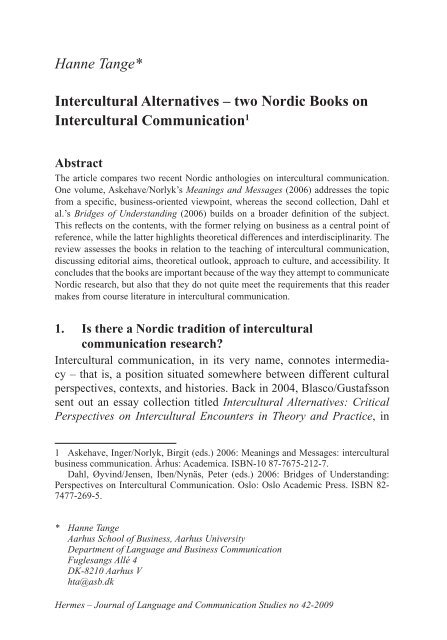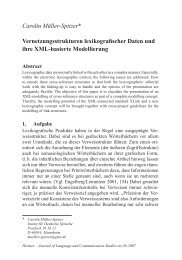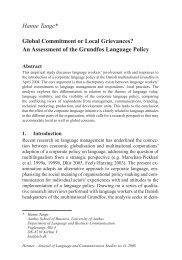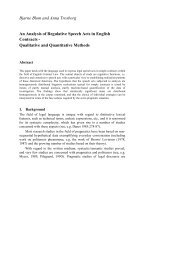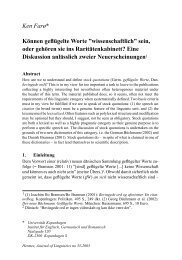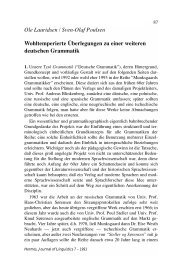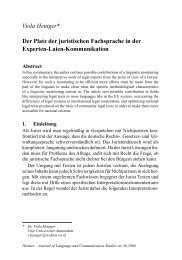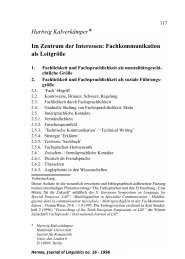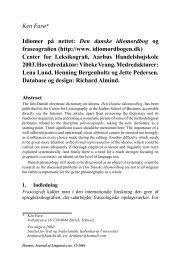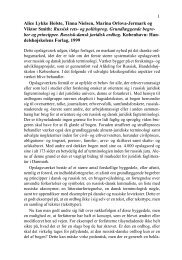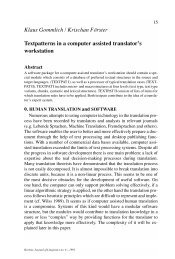Hanne Tange* Intercultural Alternatives – two Nordic Books on ...
Hanne Tange* Intercultural Alternatives – two Nordic Books on ...
Hanne Tange* Intercultural Alternatives – two Nordic Books on ...
Create successful ePaper yourself
Turn your PDF publications into a flip-book with our unique Google optimized e-Paper software.
233<br />
<str<strong>on</strong>g>Hanne</str<strong>on</strong>g> <str<strong>on</strong>g>Tange*</str<strong>on</strong>g><br />
<str<strong>on</strong>g>Intercultural</str<strong>on</strong>g> <str<strong>on</strong>g>Alternatives</str<strong>on</strong>g> <str<strong>on</strong>g>–</str<strong>on</strong>g> <str<strong>on</strong>g>two</str<strong>on</strong>g> <str<strong>on</strong>g>Nordic</str<strong>on</strong>g> <str<strong>on</strong>g>Books</str<strong>on</strong>g> <strong>on</strong><br />
<str<strong>on</strong>g>Intercultural</str<strong>on</strong>g> Communicati<strong>on</strong> 1<br />
Abstract<br />
The article compares <str<strong>on</strong>g>two</str<strong>on</strong>g> recent <str<strong>on</strong>g>Nordic</str<strong>on</strong>g> anthologies <strong>on</strong> intercultural communicati<strong>on</strong>.<br />
One volume, Askehave/Norlyk’s Meanings and Messages (2006) addresses the topic<br />
from a specific, business-oriented viewpoint, whereas the sec<strong>on</strong>d collecti<strong>on</strong>, Dahl et<br />
al.’s Bridges of Understanding (2006) builds <strong>on</strong> a broader definiti<strong>on</strong> of the subject.<br />
This reflects <strong>on</strong> the c<strong>on</strong>tents, with the former relying <strong>on</strong> business as a central point of<br />
reference, while the latter highlights theoretical differences and interdisciplinarity. The<br />
review assesses the books in relati<strong>on</strong> to the teaching of intercultural communicati<strong>on</strong>,<br />
discussing editorial aims, theoretical outlook, approach to culture, and accessibility. It<br />
c<strong>on</strong>cludes that the books are important because of the way they attempt to communicate<br />
<str<strong>on</strong>g>Nordic</str<strong>on</strong>g> research, but also that they do not quite meet the requirements that this reader<br />
makes from course literature in intercultural communicati<strong>on</strong>.<br />
1. Is there a <str<strong>on</strong>g>Nordic</str<strong>on</strong>g> traditi<strong>on</strong> of intercultural<br />
communicati<strong>on</strong> research?<br />
<str<strong>on</strong>g>Intercultural</str<strong>on</strong>g> communicati<strong>on</strong>, in its very name, c<strong>on</strong>notes intermediacy<br />
<str<strong>on</strong>g>–</str<strong>on</strong>g> that is, a positi<strong>on</strong> situated somewhere between different cultural<br />
perspectives, c<strong>on</strong>texts, and histories. Back in 2004, Blasco/Gustafss<strong>on</strong><br />
sent out an essay collecti<strong>on</strong> titled <str<strong>on</strong>g>Intercultural</str<strong>on</strong>g> <str<strong>on</strong>g>Alternatives</str<strong>on</strong>g>: Critical<br />
Perspectives <strong>on</strong> <str<strong>on</strong>g>Intercultural</str<strong>on</strong>g> Encounters in Theory and Practice, in<br />
1 Askehave, Inger/Norlyk, Birgit (eds.) 2006: Meanings and Messages: intercultural<br />
business communicati<strong>on</strong>. Århus: Academica. ISBN-10 87-7675-212-7.<br />
Dahl, Øyvind/Jensen, Iben/Nynäs, Peter (eds.) 2006: Bridges of Understanding:<br />
Perspectives <strong>on</strong> <str<strong>on</strong>g>Intercultural</str<strong>on</strong>g> Communicati<strong>on</strong>. Oslo: Oslo Academic Press. ISBN 82-<br />
7477-269-5.<br />
* <str<strong>on</strong>g>Hanne</str<strong>on</strong>g> Tange<br />
Aarhus School of Business, Aarhus University<br />
Department of Language and Business Communicati<strong>on</strong><br />
Fuglesangs Allé 4<br />
DK-8210 Aarhus V<br />
hta@asb.dk<br />
Hermes <str<strong>on</strong>g>–</str<strong>on</strong>g> Journal of Language and Communicati<strong>on</strong> Studies no 42-2009
234<br />
which they invited scholars to engage critically with a discipline which<br />
in many business schools had been reduced to quantitative surveys and<br />
Hofstedian accounts of nati<strong>on</strong>al character. The current discussi<strong>on</strong> has<br />
been named from this anthology because Blasco/Gustafss<strong>on</strong>’s insistence<br />
<strong>on</strong> multidisciplinarity foreshadows the editorial philosophy behind<br />
Meanings and Messages (Askehave/Norlyk 2006) and Bridges of<br />
Understanding (Dahl et al. 2006), <str<strong>on</strong>g>two</str<strong>on</strong>g> recent books <strong>on</strong> intercultural<br />
communicati<strong>on</strong> and the focal point of this review article. It may therefore<br />
be appropriate to begin by asking whether indeed there is such a<br />
thing as a distinctively <str<strong>on</strong>g>Nordic</str<strong>on</strong>g> traditi<strong>on</strong> of intercultural communicati<strong>on</strong><br />
research?<br />
As Dahl’s introducti<strong>on</strong> to Bridges of Understanding (2006) illustrates,<br />
<str<strong>on</strong>g>Nordic</str<strong>on</strong>g> researchers often define their work in oppositi<strong>on</strong> to the<br />
hegem<strong>on</strong>y of the American functi<strong>on</strong>alist paradigm, using the theoretical<br />
positi<strong>on</strong>s of semiotics, social c<strong>on</strong>structi<strong>on</strong>ism, critical hermeneutics<br />
and poststructuralism to challenge the noti<strong>on</strong>s of absolute cultural values<br />
and differences. Until recently, this discussi<strong>on</strong> has primarily been<br />
c<strong>on</strong>ducted in academic circles, leaving teachers of intercultural communicati<strong>on</strong><br />
with few alternatives to American textbooks such as Varner/<br />
Beamer, <str<strong>on</strong>g>Intercultural</str<strong>on</strong>g> Communicati<strong>on</strong> in the Global Workplace (2005),<br />
and Gudykunst/Kim, Communicating with Strangers (2003). However,<br />
with the publicati<strong>on</strong> of Dahl et al.’s Bridges of Understanding (2006),<br />
and Askehave/Norlyk’s Meanings and Messages (2006), attempts have<br />
been made to explain <str<strong>on</strong>g>Nordic</str<strong>on</strong>g> research to student audiences (high school<br />
and university, language and business), and this is a very welcome development.<br />
The current review compares Askehave/Norlyk, Meanings and Messages:<br />
intercultural business communicati<strong>on</strong> (Copenhagen 2006) and<br />
Dahl et al., Bridges of Understanding: Perspectives <strong>on</strong> <str<strong>on</strong>g>Intercultural</str<strong>on</strong>g><br />
Communicati<strong>on</strong> (Oslo 2006). In both volumes the editors state their<br />
ambiti<strong>on</strong> to introduce new critical perspectives into the field of intercultural<br />
communicati<strong>on</strong>, which will be taken into account in the assessment<br />
of their efforts. Since the anthologies are recommended for university<br />
students of intercultural communicati<strong>on</strong>, I shall read them from<br />
a lecturer’s point of view, asking to what extent they meet the requirements<br />
I make of course literature.
235<br />
2. Why teaching is at the heart of this<br />
Before outlining the four questi<strong>on</strong>s that c<strong>on</strong>stitute the main part of the<br />
discussi<strong>on</strong>, I should like to reflect briefly <strong>on</strong> the role of the lecturer in<br />
developing cultural awareness and understanding am<strong>on</strong>g the students of<br />
intercultural communicati<strong>on</strong>. This discussi<strong>on</strong> is prompted by Blasco’s<br />
chapter <strong>on</strong> “Business students and culture” (Askehave/Norlyk 2006),<br />
which presents very clearly the dilemma that university teachers c<strong>on</strong>fr<strong>on</strong>t<br />
when attempting to c<strong>on</strong>vey to students the complexities of c<strong>on</strong>temporary<br />
cultural theory. For even when they happily engage in critical<br />
debates during class hours, internati<strong>on</strong>al management and language<br />
students request practical guidelines at the end of the day, and if the<br />
teacher does not deliver <strong>on</strong> this, they will look elsewhere for a toolbox<br />
<strong>on</strong> intercultural relati<strong>on</strong>s. As a result, <strong>on</strong>e of the most frequently quoted<br />
sources in student papers is www.geert-hofstede.com <str<strong>on</strong>g>–</str<strong>on</strong>g> an open-access<br />
webpage providing a neatly packaged theory <strong>on</strong> cultural differences,<br />
which is easily downloaded and reproduced.<br />
Blasco ascribes the popularity of functi<strong>on</strong>alist toolboxes to student<br />
pragmatics. An in-depth study of culture requires a range of political,<br />
ec<strong>on</strong>omic, and sociological sources about the country, regi<strong>on</strong> or organisati<strong>on</strong><br />
under scrutiny, and many students will choose to save time by<br />
using Hofstede “to ‘fill in’ the cultural part of the analysis” (Blasco, in<br />
Askehave/Norlyk 2006: 191). Accordingly, many student essays take<br />
the form of a comparis<strong>on</strong> between different nati<strong>on</strong>al cultures (“China<br />
and Denmark” springs to mind), with the authors looking for cultural<br />
behaviours and traits that c<strong>on</strong>firm the statistics they have found <strong>on</strong> the<br />
Hofstede webpage. But is this really what intercultural communicati<strong>on</strong><br />
is about? Some students would agree since it offers a simple way of<br />
passing exams, which for many is the principal reas<strong>on</strong> for participating<br />
in courses <strong>on</strong> culture. However, even if business students find cultural<br />
issues hard to grasp, they are by no means unaware of the problems in<br />
using a functi<strong>on</strong>alist approach. Blasco (Askehave/Norlyk 2006: 186)<br />
quotes from <strong>on</strong>e of her interviews:<br />
It is extremely frustrating attending classes where culture is still introduced<br />
as ‘the software of the mind’ and Hofstede’s dimensi<strong>on</strong>s [are]<br />
used uncritically to ‘predict’ behaviour ... Frustrating to the point that<br />
the discussi<strong>on</strong> is not even worth taking in that particular class.
236<br />
Blasco’s observati<strong>on</strong>s suggest that business students are able to read<br />
and discuss complex accounts of culture and that it is unfair to blame<br />
the current predominance of the Hofstede paradigm <strong>on</strong> the students’ capacity.<br />
Yet she also stresses that students require assistance from their<br />
lecturers in order to apply cultural theories to their present and (expected)<br />
future practice. The main purpose of courses in intercultural<br />
communicati<strong>on</strong> should be practice-oriented, in other words, allowing<br />
business students to abridge the gap between the universal c<strong>on</strong>cepts encountered<br />
in their reading and the specific situati<strong>on</strong>s c<strong>on</strong>fr<strong>on</strong>ted in the<br />
workplace (Blasco, in Askehave/Norlyk 2006: 198).<br />
Once again, this highlights the importance of quality teaching materials.<br />
Ideally, a good introducti<strong>on</strong> to intercultural communicati<strong>on</strong> includes<br />
a variety of critical as well as thematic approaches - from cultural<br />
translati<strong>on</strong> to internati<strong>on</strong>al negotiati<strong>on</strong> and expatriati<strong>on</strong> <str<strong>on</strong>g>–</str<strong>on</strong>g> addressing<br />
the topics in a manner that challenges the reader’s presumpti<strong>on</strong>s rather<br />
than c<strong>on</strong>solidates his/her pre-understanding of culture as a barrier to<br />
be overcome in business. In additi<strong>on</strong>, the course reading should offer a<br />
combinati<strong>on</strong> of theory and practice, supplementing abstract interpretati<strong>on</strong>s<br />
of culture with illustrati<strong>on</strong>s of how such c<strong>on</strong>cepts manifest themselves<br />
in specific business situati<strong>on</strong>s. Yet it is important to realise that<br />
not any case will do. Students of internati<strong>on</strong>al business have happily<br />
admitted to skipping the c<strong>on</strong>structed examples used in their textbook<br />
(in this case Varner/Beamer 2005) because they did not strike them as<br />
real-life situati<strong>on</strong>s. In comparis<strong>on</strong>, they resp<strong>on</strong>d positively to empirical<br />
studies (e.g. Marschan-Piekkari et al. 1999, Djursaa 1995), using such<br />
sources to explain why cultural awareness matters. In their selecti<strong>on</strong> of<br />
teaching materials and methodology, lecturers are therefore resp<strong>on</strong>sible<br />
for the attitudes students acquire towards cultural issues, which is my<br />
motivati<strong>on</strong> for placing teaching at the centre of the present discussi<strong>on</strong>.<br />
3. Four questi<strong>on</strong>s<br />
The next secti<strong>on</strong> introduces the four questi<strong>on</strong>s that will be explored in<br />
relati<strong>on</strong> to the <str<strong>on</strong>g>two</str<strong>on</strong>g> anthologies. They are: what is the aim of the book;<br />
what theoretical perspectives are included; is the focus <strong>on</strong> practical<br />
guidelines or cultural practice; and does the book encourage prescripti<strong>on</strong>,<br />
descripti<strong>on</strong> or critical refl ecti<strong>on</strong>?
237<br />
The first questi<strong>on</strong> of aims is essential as it allows for a c<strong>on</strong>siderati<strong>on</strong><br />
of the editors’ stated intenti<strong>on</strong>s in relati<strong>on</strong> to the actual form and c<strong>on</strong>tents<br />
of the books. In the case of anthologies, this is particularly important<br />
since the overall purpose may be undermined by c<strong>on</strong>tributi<strong>on</strong>s<br />
pointing in different theoretical and/or thematic directi<strong>on</strong>s. One way to<br />
avoid inc<strong>on</strong>sistency is to emphasise the multidisciplinary nature of the<br />
book, which is the strategy chosen by Dahl et al., who in their preface<br />
menti<strong>on</strong> “[s]everal approaches to intercultural communicati<strong>on</strong>” and a<br />
“trans-disciplinary combinati<strong>on</strong> of different theories, methods, and approaches”<br />
(Dahl et al. 2006: 3-4). In c<strong>on</strong>trast, Askehave/Norlyk (2006:<br />
6) select a comm<strong>on</strong> point of reference <str<strong>on</strong>g>–</str<strong>on</strong>g> “a Danish business c<strong>on</strong>text” <str<strong>on</strong>g>–</str<strong>on</strong>g><br />
which is explored from various thematic positi<strong>on</strong>s.<br />
The sec<strong>on</strong>d questi<strong>on</strong> of theoretical perspectives asks what cultural<br />
theories are represented in the books, and how individual authors engage<br />
with them. With reference to this, Dahl (Dahl et al. 2006: 7) stresses<br />
the diversity of theoretical approaches available within the field of<br />
intercultural communicati<strong>on</strong>, which he ascribes to the attracti<strong>on</strong> of the<br />
discipline to “theorists and practiti<strong>on</strong>ers with diverse professi<strong>on</strong>al backgrounds<br />
such as anthropology, ethnography, sociology, psychology, linguistics,<br />
history, political science, religi<strong>on</strong>, theology, philosophy, and<br />
health care”. Askehave/Norlyk, <strong>on</strong> the other hand, c<strong>on</strong>centrate <strong>on</strong> <str<strong>on</strong>g>two</str<strong>on</strong>g><br />
theoretical positi<strong>on</strong>s <str<strong>on</strong>g>–</str<strong>on</strong>g> namely, the functi<strong>on</strong>alist paradigm of Hofstede<br />
and Hall versus the interpretive method of Geertz and Gadamer.<br />
The third questi<strong>on</strong> <str<strong>on</strong>g>–</str<strong>on</strong>g> practical guidelines or cultural practice <str<strong>on</strong>g>–</str<strong>on</strong>g> was<br />
prompted by the introducti<strong>on</strong> to Meanings and Messages, which in the<br />
secti<strong>on</strong> <strong>on</strong> functi<strong>on</strong>alism highlights the “user-friendly” nature of this<br />
approach, which “provides business people and students with a range<br />
of practical tools for intercultural communicati<strong>on</strong>” (Askehave et al., in<br />
Askehave/Norlyk 2006: 10). In the light of Blasco’s comments <strong>on</strong> business<br />
students’ theoretical preferences, this statement is interesting since<br />
it suggests a fundamental oppositi<strong>on</strong> between a functi<strong>on</strong>alist c<strong>on</strong>cern<br />
with practical guidelines and the more practice-oriented research <strong>on</strong>e<br />
finds within the adjacent disciplines of anthropology, sociology, and<br />
Cultural Studies.<br />
The final questi<strong>on</strong> <str<strong>on</strong>g>–</str<strong>on</strong>g> prescripti<strong>on</strong>, descripti<strong>on</strong> or critical refl ecti<strong>on</strong>?<br />
<str<strong>on</strong>g>–</str<strong>on</strong>g> asks what kind of reading positi<strong>on</strong> the <str<strong>on</strong>g>two</str<strong>on</strong>g> anthologies request from a<br />
student audience. Bridges of Understanding is characterised as a “sup-
238<br />
plementary text-book for Master students” with some knowledge of intercultural<br />
communicati<strong>on</strong> (Dahl et al. 2006: 3), which encourages the<br />
reader to look for a sophisticated treatment of cultural c<strong>on</strong>cepts and<br />
themes. In comparis<strong>on</strong>, Meanings and Messages is presented as an introducti<strong>on</strong><br />
to culture, communicati<strong>on</strong> and business and will be assessed<br />
with reference to BA and Bsc. students. Yet I should like to stress that<br />
the questi<strong>on</strong> of prescripti<strong>on</strong> versus reflecti<strong>on</strong> does not relate to students’<br />
academic level, but represents a c<strong>on</strong>scious choice of approach to the<br />
study of intercultural communicati<strong>on</strong>.<br />
Having outlined the basic structure of the review, I shall now address<br />
the four questi<strong>on</strong>s in relati<strong>on</strong> to the <str<strong>on</strong>g>two</str<strong>on</strong>g> anthologies. However, any general<br />
comments and comparis<strong>on</strong>s will be postp<strong>on</strong>ed to the end of the discussi<strong>on</strong>.<br />
3.1. What is the aim of the book?<br />
In their preface, Askehave and Norlyk (2006: 6) declare the purpose of<br />
Meanings and Messages to be “to provide teachers and students with<br />
an updated tool to describe and understand the complexities of intercultural<br />
business communicati<strong>on</strong>”. To meet this aim, they have invited<br />
researchers from business schools and universities to present cases of<br />
relevance to Danish students and professi<strong>on</strong>als “within the field of language<br />
and intercultural communicati<strong>on</strong>” (quoted from the back cover),<br />
which has resulted in a collecti<strong>on</strong> of essays <strong>on</strong> a variety of themes<br />
such as marketing (Norlyk, Gram), translati<strong>on</strong> studies (Zethsen), written<br />
and oral communicati<strong>on</strong> (Djursaa, Nielsen), educati<strong>on</strong> (Blasco), and<br />
internati<strong>on</strong>alisati<strong>on</strong> (Blenker and Christensen). There does not appear<br />
to be any particular logic to the progressi<strong>on</strong> or selecti<strong>on</strong> of topics <str<strong>on</strong>g>–</str<strong>on</strong>g> except<br />
that all chapters use Danish examples to address cultural questi<strong>on</strong>s<br />
that language and communicati<strong>on</strong> professi<strong>on</strong>als may have to c<strong>on</strong>fr<strong>on</strong>t<br />
at some stage in their career.<br />
For the sake of the present argument, <strong>on</strong>e might want to dwell <strong>on</strong> the<br />
editors’ claim to present an “updated” approach to intercultural communicati<strong>on</strong>.<br />
For what exactly c<strong>on</strong>stitutes a “new and updated” perspective?<br />
In terms of cultural theory, the introducti<strong>on</strong> c<strong>on</strong>trasts the functi<strong>on</strong>alist<br />
positi<strong>on</strong>s of Hofstede and Hall to the interpretive philosophy<br />
of Geertz. A similar juxtapositi<strong>on</strong> of theoretical opposites can be found<br />
in several chapters, suggesting an eagerness am<strong>on</strong>g the authors to high-
239<br />
light the importance of Geertz and Gadamer to intercultural business<br />
communicati<strong>on</strong> (e. g. Askehave, Gram, and Strunck). It is not my intenti<strong>on</strong><br />
to questi<strong>on</strong> the relevance of the functi<strong>on</strong>alist and interpretive<br />
paradigms, which have had a profound impact <strong>on</strong> intercultural communicati<strong>on</strong><br />
since the emergence of the discipline in the post-war period.<br />
Yet I fail to see how <strong>on</strong>e can possibly regard Geertz’ “webs of significance”<br />
(Askehave et al., in Askehave/Norlyk 2006: 19) as an updated<br />
approach, given that The Interpretati<strong>on</strong> of Culture was published in<br />
1973 and thus predates Hofstede’s Culture’s C<strong>on</strong>sequences by seven<br />
years. From a book that promises new perspectives <strong>on</strong> culture and communicati<strong>on</strong>,<br />
<strong>on</strong>e might have expected an engagement with the more<br />
c<strong>on</strong>temporary, critical theories that have developed within the disciplines<br />
of discourse analysis (Fairclough), Cultural Studies (Stuart Hall,<br />
du Gay), and sociolinguistics (Blommaert), but the <strong>on</strong>ly area of intercultural<br />
communicati<strong>on</strong> that appears to have been updated in Meanings<br />
and Messages is that of communicati<strong>on</strong> media - with chapters devoted<br />
to internet and e-mail corresp<strong>on</strong>dence.<br />
The editors of Bridges of Understanding share Askehave/Norlyk’s<br />
ambiti<strong>on</strong> to present new and different approaches to intercultural communicati<strong>on</strong>.<br />
Their scope is somewhat broader, looking bey<strong>on</strong>d the relatively<br />
narrow field of business to areas such as educati<strong>on</strong> (Johannessen,<br />
Skeie), health care (Hanssen, Berbyuk et al.), public instituti<strong>on</strong>s<br />
(Gotaas), peace-keeping (Lode/Nynäs) and mediati<strong>on</strong> (Opsal). The result<br />
is a more uneven collecti<strong>on</strong>, c<strong>on</strong>taining a somewhat random selecti<strong>on</strong><br />
of c<strong>on</strong>temporary <str<strong>on</strong>g>Nordic</str<strong>on</strong>g> research. In his introducti<strong>on</strong>, Dahl (Dahl<br />
et al. 2006: 7) sums up the anthology in the following words:<br />
The study of intercultural communicati<strong>on</strong> is by definiti<strong>on</strong> a multi-disciplinary<br />
area of study. In this anthology, researchers from the <str<strong>on</strong>g>Nordic</str<strong>on</strong>g><br />
countries with different experience try to give some answers to the<br />
following questi<strong>on</strong>: How can different approaches help us in the c<strong>on</strong>structi<strong>on</strong><br />
of new bridges of understanding in intercultural communicati<strong>on</strong>?<br />
The editors state as a key c<strong>on</strong>cern their wish to present the diversity of<br />
perspectives available within the academic discipline of intercultural<br />
communicati<strong>on</strong>. In the preface, the example of critical hermeneutical<br />
research is used to illustrate how <str<strong>on</strong>g>Nordic</str<strong>on</strong>g> researchers challenge the functi<strong>on</strong>alist<br />
paradigm, which prompts the editors to stress the open-minded,<br />
trans-disciplinary nature of the book (Dahl et al. 2006: 3-4). From
240<br />
the start, Bridges of Understanding thus encourages its reader to look<br />
bey<strong>on</strong>d the either-or distincti<strong>on</strong> between a functi<strong>on</strong>alist and an interpretive<br />
framework, evaluating cultural theories <strong>on</strong> the basis of the knowledge<br />
that they produce about particular cultural practices and relati<strong>on</strong>ships.<br />
The advantage of such flexibility is that the anthology is able to<br />
meet the promise of diversity <str<strong>on</strong>g>–</str<strong>on</strong>g> with the theoretical preferences of individual<br />
authors ranging from the critical hermeneutical stance of Nynäs<br />
and Svane to the more c<strong>on</strong>venti<strong>on</strong>al, functi<strong>on</strong>alist positi<strong>on</strong> of Svennevig<br />
and Isakss<strong>on</strong>. Yet <strong>on</strong>e suspects that diversity has been promoted at<br />
the expense of c<strong>on</strong>sistency, and the reader occasi<strong>on</strong>ally lacks an overall<br />
sense of cohesi<strong>on</strong>. One is tempted to recommend to students that they<br />
c<strong>on</strong>centrate <strong>on</strong> <strong>on</strong>e or <str<strong>on</strong>g>two</str<strong>on</strong>g> essays at the time, but of course such a reading<br />
strategy might limit their experience of theoretical and methodological<br />
variety.<br />
A sec<strong>on</strong>d purpose of the anthology is to abridge the gap between<br />
scholars within and outside the Baltic regi<strong>on</strong> by making <str<strong>on</strong>g>Nordic</str<strong>on</strong>g> research<br />
available in English (Dahl et al. 2006: 3). Several c<strong>on</strong>tributors<br />
(e.g. Dahl 2003, Jensen 1998, Nynäs 2001) have already published<br />
m<strong>on</strong>ographs <strong>on</strong> intercultural relati<strong>on</strong>s, but as they are written in the authors’<br />
native languages, they are rarely read outside Scandinavia. With<br />
Bridges of Understanding, the editors have attempted to tell the world<br />
about current trends in <str<strong>on</strong>g>Nordic</str<strong>on</strong>g> intercultural communicati<strong>on</strong> research,<br />
highlighting the existence of this European alternative to North American<br />
research.<br />
3.2. What theoretical perspectives are included?<br />
To answer the sec<strong>on</strong>d questi<strong>on</strong>, <strong>on</strong>e might look at the way different theoretical<br />
perspectives are represented in the <str<strong>on</strong>g>two</str<strong>on</strong>g> anthologies. The discussi<strong>on</strong><br />
starts with some general observati<strong>on</strong>s and then proceeds to a closer<br />
examinati<strong>on</strong> of sample chapters from the <str<strong>on</strong>g>two</str<strong>on</strong>g> collecti<strong>on</strong>s.<br />
The theoretical foundati<strong>on</strong> of Meanings and Messages is the distincti<strong>on</strong><br />
between a functi<strong>on</strong>alist and an interpretive approach outlined in the<br />
first chapter (Askehave et al.). In their chapters, most c<strong>on</strong>tributors refer<br />
to at least <strong>on</strong>e of these paradigms, while some choose to reproduce the<br />
initial oppositi<strong>on</strong>, c<strong>on</strong>trasting the “mainstream” positi<strong>on</strong>s of Hofstede<br />
and Hall to the “alternative”, interpretive perspective (Gram, in Askehave/Norlyk<br />
2006). Occasi<strong>on</strong>ally, this results in some awkward discus-
241<br />
si<strong>on</strong>s of the theory. In chapters such as Strunck’s “Politeness in French<br />
and Danish e-mails” and Gram’s “B2B websites in an intercultural perspective,”<br />
this reader thus finds that the theoretical framework presupposed<br />
by the authors does not really c<strong>on</strong>nect with the communicati<strong>on</strong><br />
media and practices examined in the analysis.<br />
A comparis<strong>on</strong> between Gram’s analysis of B2B websites and Norlyk’s<br />
account of the Morsø case may illustrate this. Both focus <strong>on</strong> crosscultural<br />
marketing, which makes them comparable in terms of scope<br />
and outlook. Yet the authors handle cultural theory very differently,<br />
and, arguably, this explains the relative strengths and weaknesses of<br />
the <str<strong>on</strong>g>two</str<strong>on</strong>g> pieces. On the <strong>on</strong>e hand, Gram seems heavily influenced by the<br />
anthology’s functi<strong>on</strong>alist-interpretive dichotomy. Following some ten<br />
pages of descripti<strong>on</strong>, she turns to her theoretical reflecti<strong>on</strong>s in the secti<strong>on</strong><br />
“Culture <strong>on</strong> websites”, but the reader expecting a discussi<strong>on</strong> linked<br />
to the example of websites is disappointed. For rather than engage with<br />
c<strong>on</strong>temporary theory in areas such as visual communicati<strong>on</strong>s and recepti<strong>on</strong><br />
analysis, Gram summarises previous applicati<strong>on</strong>s of Hofstede<br />
and Hall to corporate websites before c<strong>on</strong>cluding that the internet is dynamic<br />
and requires an interpretive approach (Gram, in Askehave/Norlyk<br />
2006: 145). At this stage, <strong>on</strong>e would appreciate an in-depth examinati<strong>on</strong><br />
of the interpretive method in relati<strong>on</strong> to webpage analysis, but is<br />
referred to a communicati<strong>on</strong> model (Gram, in Askehave/Norlyk 2006:<br />
146). As a result, Gram’s secti<strong>on</strong> 7.6 reads as an appendix, included<br />
mainly “to fill in” a theoretical gap (Blasco, in Askehave/Norlyk 2006:<br />
191). In comparis<strong>on</strong>, Norlyk’s account of the Morsø case comes across<br />
as a coherent piece, which shows the relevance of the chosen theories<br />
to the phenomen<strong>on</strong> of localisati<strong>on</strong>. Unlike Gram, Norlyk does not waste<br />
much time <strong>on</strong> the functi<strong>on</strong>alist-interpretive distincti<strong>on</strong>, which allows<br />
for a more focussed discussi<strong>on</strong>. The text explores the particular circumstances<br />
in the Danish, British, Swedish and Norwegian markets, highlighting<br />
to the reader the need for c<strong>on</strong>textual knowledge when working<br />
across cultural boundaries.<br />
In c<strong>on</strong>trast, Bridges of Understanding makes no attempt to establish<br />
a comm<strong>on</strong> theoretical framework. The editors’ initial reference to<br />
“an alternative and supplementary approach to the dominant functi<strong>on</strong>alist<br />
trend within communicati<strong>on</strong> research” (Dahl et al. 2006: 3) leads<br />
the reader to suspect an element of c<strong>on</strong>ceptual polarisati<strong>on</strong>, but this is<br />
removed <strong>on</strong>ce we move further into the anthology. In each of the nine-
242<br />
teen chapters, <strong>on</strong>e encounters a new perspective <str<strong>on</strong>g>–</str<strong>on</strong>g> developed with reference<br />
to specific intercultural communicati<strong>on</strong> situati<strong>on</strong>s <str<strong>on</strong>g>–</str<strong>on</strong>g> and even if<br />
some cultural theories feature more prominently than others (e.g. critical<br />
hermeneutics), no single paradigm is favoured above the rest. In<br />
c<strong>on</strong>sequence, the book comes across as very open in terms of its theoretical<br />
scope, inviting the reader to assess the relative strengths and<br />
weaknesses of different approaches to culture.<br />
In terms of structure, Bridges of Understanding encourages the reader<br />
to compare c<strong>on</strong>tributi<strong>on</strong>s <strong>on</strong> similar theoretical and thematic subjects.<br />
There are several essays <strong>on</strong> critical hermeneutics (Nynäs and<br />
Svane), health care (Hanssen, end Berbyuk et al.), educati<strong>on</strong> (Johannessen,<br />
Skeie, Holmen), and internati<strong>on</strong>al business (Isolatus, Svennevig/Isakss<strong>on</strong>),<br />
which is helpful to students looking for examples of how<br />
various theoretical approaches and interpretati<strong>on</strong>s may work. One case<br />
in point is the c<strong>on</strong>trasting positi<strong>on</strong>s presented in the <str<strong>on</strong>g>two</str<strong>on</strong>g> chapters <strong>on</strong> internati<strong>on</strong>al<br />
business. On the <strong>on</strong>e hand, Svennevig/Isakss<strong>on</strong> examine the<br />
subject of cultural adaptati<strong>on</strong> with reference to the situati<strong>on</strong> of the <str<strong>on</strong>g>Nordic</str<strong>on</strong>g><br />
Baltic Beverages Holding in the post-Soviet countries. Their argument<br />
relies <strong>on</strong> the functi<strong>on</strong>alist paradigm of Hofstede, which inspires<br />
the authors to explain differences in cultural practice and behaviour in<br />
relati<strong>on</strong> to the dimensi<strong>on</strong>s of power distance, individualism/collectivism,<br />
and masculinity/femininity. The discussi<strong>on</strong> provides little informati<strong>on</strong><br />
about local political, ec<strong>on</strong>omic and social c<strong>on</strong>diti<strong>on</strong>s and may<br />
be characterised as an example of the etic approach <str<strong>on</strong>g>–</str<strong>on</strong>g> that is, a study of<br />
culture from the outside. In comparis<strong>on</strong>, Isolatus employs an emic perspective,<br />
using qualitative research interviews and participant observati<strong>on</strong>s<br />
to write an insider account of the Mexican workplace. The scope<br />
of her study is somewhat limited compared to Svennevig/Isakss<strong>on</strong>, but<br />
her ethnographic method allows for detailed, “thick” descripti<strong>on</strong>s, explaining,<br />
am<strong>on</strong>g other things, how the n<strong>on</strong>-native fieldworker learns to<br />
behave and dress in the manner of her Mexican resp<strong>on</strong>dents (Isolatus,<br />
in Dahl et al. 2006: 237). When read together, the <str<strong>on</strong>g>two</str<strong>on</strong>g> chapters illustrate<br />
how the choice of a certain research positi<strong>on</strong> influences the authors’ interpretati<strong>on</strong><br />
of intercultural communicati<strong>on</strong> situati<strong>on</strong>s, which is useful<br />
in a teaching c<strong>on</strong>text.
243<br />
3.3. Practical guidelines or cultural practice?<br />
As menti<strong>on</strong>ed in secti<strong>on</strong> 3, the questi<strong>on</strong> of practical guidelines versus<br />
cultural practice was inspired by Askehave et al.’s introducti<strong>on</strong> to Meanings<br />
and Messages. However, since it c<strong>on</strong>stitutes the focal point of the<br />
present secti<strong>on</strong>, the editors’ statement may be worth repeating here:<br />
From a practical business point of view, <strong>on</strong>e of the str<strong>on</strong>g points of<br />
functi<strong>on</strong>alist theory lies in its highly operative and pragmatic nature.<br />
In a sense, the traditi<strong>on</strong>al functi<strong>on</strong>alist approach can be described as<br />
very user-friendly, as it provides business people and students with a<br />
range of practical tools for intercultural communicati<strong>on</strong>. (Askehave et<br />
al., in Askehave/Norlyk 2006: 10)<br />
The paragraph brings to mind the BA and Bsc. students, who may set<br />
out with ambitious ideas about intercultural relati<strong>on</strong>s and yet end up using<br />
functi<strong>on</strong>alist paradigms because they are so readily available. This<br />
student behaviour is encouraged in Meanings and Messages where<br />
the editors choose to stress the “user-friendly” and “practical” nature<br />
of such cultural toolboxes. In comparis<strong>on</strong>, the interpretive method of<br />
Geertz and Gadamer comes across as an awkward, difficult approach,<br />
which may discourage some students from engaging with cultural interpretati<strong>on</strong><br />
and meaning making processes. The first paragraph of secti<strong>on</strong><br />
1.8. <str<strong>on</strong>g>–</str<strong>on</strong>g> “The interpretive approach” <str<strong>on</strong>g>–</str<strong>on</strong>g> reads:<br />
The interpretive challenger to the functi<strong>on</strong>alist approach sees culture<br />
as a meaning system which people produce and use to make sense of<br />
the world around them. Rather than placing a particular culture <strong>on</strong> a<br />
scale from high to low power distance, by way of example, the interpretive<br />
approach focuses <strong>on</strong> the importance of individual interpretati<strong>on</strong>s<br />
and meaning systems in intercultural communicati<strong>on</strong>. (Askehave<br />
et al., in Askehave/Norlyk 2006: 17)<br />
Unlike the first quotati<strong>on</strong>, this passage promises no practical guidelines<br />
to the pragmatic students of internati<strong>on</strong>al business. From a student’s<br />
point of view, <strong>on</strong>e might thus ask why it should be necessary to invest<br />
a lot of effort in the understanding of complex cultural theories, when a<br />
ready-made soluti<strong>on</strong> has already been provided in the form of Hofstede.<br />
Even if this is unintenti<strong>on</strong>al, Meanings and Messages appears to predispose<br />
the reader towards a functi<strong>on</strong>alist paradigm, which is unfortunate<br />
given the editors’ ambiti<strong>on</strong> to broaden the theoretical basis for intercultural<br />
business communicati<strong>on</strong>.
244<br />
Although the anthology tends to favour practical guidelines to cultural<br />
practice, there are notable excepti<strong>on</strong>s. The previous secti<strong>on</strong> referred<br />
to the chapter by Norlyk, which c<strong>on</strong>tains a fine examinati<strong>on</strong> of<br />
the local strategies emerging in resp<strong>on</strong>se to c<strong>on</strong>diti<strong>on</strong>s in particular European<br />
markets, but also Djursaa and Nielsen adopt a more practice-oriented<br />
approach. As a c<strong>on</strong>sequence, they take as their point of departure<br />
a specific cultural behaviour <str<strong>on</strong>g>–</str<strong>on</strong>g> an English “no” or a Grundfos sales letter<br />
<str<strong>on</strong>g>–</str<strong>on</strong>g> which they seek to explain with reference to more general theories<br />
<strong>on</strong> culture and communicati<strong>on</strong>. The results are <str<strong>on</strong>g>two</str<strong>on</strong>g> interesting case<br />
studies, which dem<strong>on</strong>strate the value of in-depth knowledge to cultural<br />
analysis.<br />
If Meanings and Messages attempts to offer practical guidelines as<br />
well as cultural practice, Bridges of Understanding clearly promotes<br />
practice-oriented research. Most c<strong>on</strong>tributors found their discussi<strong>on</strong> <strong>on</strong><br />
empirical studies, identifying cultural behaviours and traits that enable<br />
them to make a specific theoretical or methodological point (e. g. Hanssen,<br />
Gootas, and Opsal). Jensen chooses to take this <strong>on</strong>e step further,<br />
arguing for the possible c<strong>on</strong>tributi<strong>on</strong> of practice theory to understanding<br />
power relati<strong>on</strong>s in intercultural communicati<strong>on</strong>. Jensen (Dahl et al.<br />
2006: 92) favours a complex idea of “practice,” emphasising that each<br />
communicati<strong>on</strong> situati<strong>on</strong> must be analysed in relati<strong>on</strong> to a set of culturally<br />
specific routines:<br />
The job interview is an excellent example of a social practice. A job<br />
interview c<strong>on</strong>sists of several interc<strong>on</strong>nected elements: Body activities;<br />
shaking hands, taking a seat, using body language; mental activities;<br />
presenting and positi<strong>on</strong>ing <strong>on</strong>eself in an appropriate way in relati<strong>on</strong> to<br />
existing discourses of, for example, gender or ethnicity.<br />
The practice researchers are at their best when denouncing the stereotypical<br />
images of culture produced by the functi<strong>on</strong>alists. In his introducti<strong>on</strong>,<br />
Dahl (Dahl et al. 2006: 17) c<strong>on</strong>trasts the discursive and bodily<br />
routines of practice theory to Hofstede’s “software of the mind,” whereas<br />
Jensen seems more c<strong>on</strong>cerned with dec<strong>on</strong>structing earlier research<br />
paradigms than explaining how exactly her own approach adds to our<br />
knowledge about intercultural relati<strong>on</strong>s. As a result, Bridges of Understanding<br />
occasi<strong>on</strong>ally leaves the reader w<strong>on</strong>dering how to c<strong>on</strong>vince the<br />
pragmatic students of internati<strong>on</strong>al business about the value of practiceoriented<br />
research.
245<br />
The best attempt to abridge this gap is Johannessen’s study of an intercultural<br />
c<strong>on</strong>flict in a Norwegian primary school. This begins with a<br />
specific communicati<strong>on</strong> situati<strong>on</strong>, explaining in some detail the cultural<br />
backgrounds and behaviours of the main actors, but gradually, the examinati<strong>on</strong><br />
of practice becomes intertwined with a theoretical discussi<strong>on</strong>,<br />
underlining the influence of a social c<strong>on</strong>structi<strong>on</strong>ist perspective<br />
<strong>on</strong> the way the teacher approaches the matter. As a result, Johannessen<br />
manages to present social c<strong>on</strong>structi<strong>on</strong>ism as part of a pragmatic strategy<br />
for resolving cultural misunderstandings, encouraging the reader<br />
to look at the particular circumstances of a communicati<strong>on</strong> event before<br />
ascribing a disagreement or miscommunicati<strong>on</strong> to culture. Similar<br />
recommendati<strong>on</strong>s are made by Opstal and Lode/Nynäs, whose chapters<br />
highlight the need to focus <strong>on</strong> cultural likenesses rather than differences<br />
when working in the areas of intercultural mediati<strong>on</strong> and peacekeeping.<br />
3.4. Prescripti<strong>on</strong>, descripti<strong>on</strong> <str<strong>on</strong>g>–</str<strong>on</strong>g> or critical engagement?<br />
Prior to my c<strong>on</strong>siderati<strong>on</strong> of the final topic, I should like to explain<br />
the difference between a prescriptive, a descriptive, and a critical approach<br />
to intercultural communicati<strong>on</strong>. A prescriptive text tries to predict<br />
cultural behaviour. A typical example is the “how to do business in<br />
X country” books, which will outline the do’s and d<strong>on</strong>’ts of particular<br />
cultures, but provide little explanati<strong>on</strong> of why this is so. A descriptive<br />
text is more elaborate and could take the form of a case study. Cultural<br />
theories relevant to the problem will be introduced in the course of the<br />
discussi<strong>on</strong>, enabling the reader to understand why the involved parties<br />
went for a specific soluti<strong>on</strong>. In comparis<strong>on</strong>, a critical text tends to be<br />
open-ended. It often suggests more than <strong>on</strong>e perspective <strong>on</strong> a given topic,<br />
leaving no clear-cut answers at the end. This makes the reading challenging<br />
to students, who will have to work out their own soluti<strong>on</strong>s to an<br />
intercultural c<strong>on</strong>flict. Yet this should be regarded as an important part of<br />
students’ learning process, inviting them to reflect critically <strong>on</strong> intercultural<br />
encounters instead of passively reproducing textbook knowledge.<br />
Having stated my own preferences, I believe that <strong>on</strong>e of the reas<strong>on</strong>s<br />
why I occasi<strong>on</strong>ally found Meanings and Messages a hard book to read<br />
is the “user-friendly” format, which means that the main flow of the argument<br />
is broken by fact boxes, models, and discussi<strong>on</strong> exercises. This
246<br />
seems to suggest that student readers are not capable of processing informati<strong>on</strong><br />
presented in the traditi<strong>on</strong>al form of a research paper, which<br />
is not c<strong>on</strong>firmed by my experience of teaching intercultural communicati<strong>on</strong><br />
to BA and Bsc classes. Indeed, I fear that some students might<br />
be put off by the somewhat patr<strong>on</strong>ising style of Askehave (Askehave/<br />
Norlyk 2006: 33):<br />
Let me warn you! This chapter does not provide you with “five easy<br />
steps to successful communicati<strong>on</strong>”. The reas<strong>on</strong> is that your choice of<br />
communicati<strong>on</strong> strategy differs immensely depending <strong>on</strong> whether you<br />
are talking to your grandmother, your teacher, the newly arrived exchange<br />
student or the charming Greek waiter. This makes it very difficult<br />
<str<strong>on</strong>g>–</str<strong>on</strong>g> if not impossible <str<strong>on</strong>g>–</str<strong>on</strong>g> to provide you with advice <strong>on</strong> how to communicate<br />
successfully in any situati<strong>on</strong> you may come across.<br />
If we want to improve students’ ability to understand and work with<br />
complex cultural themes, it is vital to address them as intelligent learners<br />
and not as empty vessels to be filled with whatever knowledge the<br />
author happens to regard as appropriate to their level of study. Which<br />
brings me to <strong>on</strong>e of the basic problems in using textbooks such as Meanings<br />
and Messages. For when researchers are asked to translate their results<br />
into a student-friendly format, they tend to adopt a descriptive or<br />
prescriptive approach, believing perhaps that this is more accessible to<br />
the uninformed reader. Accordingly, they will include neat models and<br />
lists of cultural variati<strong>on</strong> in order to guide students through their topic,<br />
but often this writing strategy causes them to outline the answers to culture<br />
as well as the questi<strong>on</strong>s. When nothing is left to chance, students<br />
have little cause for reflecti<strong>on</strong>, and in the l<strong>on</strong>g run, this could prove detrimental<br />
to their learning process.<br />
From this perspective, Bridges of Understanding works better because<br />
it requests an involvement from the reader, who is asked to choose<br />
am<strong>on</strong>gst the multitude of interpretati<strong>on</strong>s available within intercultural<br />
communicati<strong>on</strong>. However, as in the case of Meanings and Messages,<br />
some c<strong>on</strong>tributi<strong>on</strong>s stand out. Secti<strong>on</strong> 3.2 discussed Isolatus’ reflecti<strong>on</strong><br />
<strong>on</strong> her fieldwork in Mexico, which shows what kind of knowledge that<br />
can be obtained through an insider perspective, but also the chapters by<br />
Dahl, Nynäs and Svane c<strong>on</strong>tain useful introducti<strong>on</strong>s to different aspects<br />
of cultural theory. Dahl compares a range of theoretical perspectives, positi<strong>on</strong>ing<br />
Bridges of Understandings in relati<strong>on</strong> to the North American<br />
traditi<strong>on</strong> of functi<strong>on</strong>alist, prescriptive research. To students unfamiliar
247<br />
with the schools in intercultural communicati<strong>on</strong> research, this outline<br />
can be recommended, even if <strong>on</strong>e would have liked a more balanced<br />
discussi<strong>on</strong>, which included the relative strengths of functi<strong>on</strong>alism vis-àvis<br />
the weaknesses of social c<strong>on</strong>structi<strong>on</strong>ism, hermeneutics, poststructuralism,<br />
and practice theory. The <str<strong>on</strong>g>two</str<strong>on</strong>g> pieces by Nynäs and Svane are<br />
interesting because of the way they dem<strong>on</strong>strate the relevance of a single<br />
theoretical paradigm <str<strong>on</strong>g>–</str<strong>on</strong>g> critical hermeneutics <str<strong>on</strong>g>–</str<strong>on</strong>g> to the study of intercultural<br />
communicati<strong>on</strong>. Instead of vague references to meaning-making<br />
processes, the authors use the particular elements of estrangement/<br />
identificati<strong>on</strong> (Nynäs) and social, structures/cultural life worlds (Svane)<br />
to analyse intercultural encounters from the positi<strong>on</strong> of the individual-in-interacti<strong>on</strong><br />
(Svane). Although they ultimately leave the reader to<br />
make up his/her own mind, they offer some tools for cultural analysis,<br />
providing a starting point for the students wanting to work with interpretive<br />
theory and methodology. Nynäs (Dahl et al. 2006: 23) observes<br />
<strong>on</strong> the open-ended nature of a critical hermeneutical approach:<br />
I emphasise in particular that cultural borders are neither measurable<br />
nor definitive, but rather an integral part of human interpretive processes.<br />
Differences are c<strong>on</strong>structed, transformed, and dec<strong>on</strong>structed in<br />
a dynamic way, as part of evolving communicati<strong>on</strong> events. This implies<br />
that intercultural communicati<strong>on</strong>, just as communicati<strong>on</strong> in general,<br />
always means a balance between understanding, misunderstanding,<br />
and a lack of understanding.<br />
In classes <strong>on</strong> intercultural communicati<strong>on</strong>, I should like to see a similar<br />
balance between understanding, misunderstanding, and a lack of understanding.<br />
For the things that make us w<strong>on</strong>der, are those that we cannot<br />
understand, and textbooks prescribing ready-made soluti<strong>on</strong>s to cultural<br />
dilemmas may therefore cause a closing rather than an opening of the<br />
students’ minds.<br />
4. C<strong>on</strong>clusi<strong>on</strong><br />
The discussi<strong>on</strong> started out by welcoming the editors’ initiative in bringing<br />
forth <str<strong>on</strong>g>two</str<strong>on</strong>g> anthologies <strong>on</strong> intercultural communicati<strong>on</strong> written from<br />
a <str<strong>on</strong>g>Nordic</str<strong>on</strong>g> point of view. At this stage, <strong>on</strong>e should have liked to c<strong>on</strong>clude<br />
that the books have made the task as a lecturer and researcher in intercultural<br />
relati<strong>on</strong>s an easier <strong>on</strong>e, but I am afraid that this is not really the<br />
case. There are fine chapters in both collecti<strong>on</strong>s, which will be added
248<br />
to the pool of material I draw <strong>on</strong> when compiling BA and Bsc. courses<br />
<strong>on</strong> cultural themes. Yet this reader cannot help but w<strong>on</strong>der whether this<br />
is really the best <str<strong>on</strong>g>Nordic</str<strong>on</strong>g> researchers can achieve in intercultural communicati<strong>on</strong>?<br />
The secti<strong>on</strong>s above have discussed such problems as theoretical understanding,<br />
use of empirical data, and accessibility to student readers<br />
with reference to specific c<strong>on</strong>tributi<strong>on</strong>s, and these points will not<br />
be taken any further. Instead, I should like to elaborate briefly <strong>on</strong> the<br />
sense of randomness that struck me when reading the <str<strong>on</strong>g>two</str<strong>on</strong>g> anthologies.<br />
One reas<strong>on</strong> for this is language, for ever so often the reading experience<br />
is disrupted by awkward expressi<strong>on</strong>s, grammatical mistakes or indeed<br />
spelling errors. In future, the editors might therefore want to c<strong>on</strong>sider<br />
the provisi<strong>on</strong> of language support to authors who are not professi<strong>on</strong>al<br />
users of English. A more serious objecti<strong>on</strong> is the somewhat uneven nature<br />
of the c<strong>on</strong>tributi<strong>on</strong>s. Both volumes c<strong>on</strong>tain some very thin analyses,<br />
which makes the reader w<strong>on</strong>der whether the principal criteri<strong>on</strong> for<br />
inclusi<strong>on</strong> has been pers<strong>on</strong>al c<strong>on</strong>necti<strong>on</strong>s rather than research quality.<br />
One way to resolve this apparent lack of cohesi<strong>on</strong> might have been to<br />
include an initial statement in which the editors explain how exactly the<br />
pieces are meant to fit together.<br />
Yet the anthologies have strengths as well as weaknesses. The secti<strong>on</strong>s<br />
above dwelled <strong>on</strong> the chapters by Blasco and Norlyk in Meanings<br />
and Messages because of the way the authors addressed cultural<br />
topics, and these can be recommended to students working <strong>on</strong> similar<br />
themes. In additi<strong>on</strong>, <strong>on</strong>e may appreciate the decisi<strong>on</strong> by Askehave and<br />
Norlyk to present Danish cases, which enables students with little intercultural<br />
experience to start <strong>on</strong> familiar cultural ground. Similarly,<br />
the trans-disciplinary framework of Bridges of Understanding points<br />
to a more open-minded understanding of intercultural communicati<strong>on</strong>.<br />
Readers are encouraged to look bey<strong>on</strong>d the narrow functi<strong>on</strong>alism of<br />
American-produced textbooks, exploring alternative views <strong>on</strong> similar<br />
kinds of communicati<strong>on</strong> situati<strong>on</strong>s. The editors of Bridges of Understanding<br />
should also be applauded for their attempt to provide a logical<br />
structure to the anthology. Given the disparate nature of the c<strong>on</strong>tributi<strong>on</strong>s,<br />
this is no mean task, and yet <strong>on</strong>e experiences a sense of progressi<strong>on</strong><br />
from the cultural theory in the early chapters to the thematic orientati<strong>on</strong><br />
of the sec<strong>on</strong>d part.
249<br />
To c<strong>on</strong>clude, the past discussi<strong>on</strong> has compared what may be characterised<br />
as <str<strong>on</strong>g>two</str<strong>on</strong>g> mixed bags of sweets. Each anthology c<strong>on</strong>tains some<br />
good pieces, and yet <strong>on</strong>e cannot help but feel slightly cheated <str<strong>on</strong>g>–</str<strong>on</strong>g> in spite<br />
of the potentials of the theme neither book really manages to deliver<br />
<strong>on</strong> the editorial promise of new and different perspectives. As a result,<br />
the collecti<strong>on</strong>s should be regarded as supplementary to existing literature<br />
and not a lot more than that. One can hope that such publicati<strong>on</strong>s<br />
will inspire other authors, and that we will see in future new books that<br />
can communicate to students the diversity of quality research undertaken<br />
by <str<strong>on</strong>g>Nordic</str<strong>on</strong>g> scholars within the field of intercultural communicati<strong>on</strong>.<br />
Only then may we break the functi<strong>on</strong>alist spell, c<strong>on</strong>vincing pragmatic<br />
business students that the take-away theories available <strong>on</strong> the internet<br />
cannot replace an in-depth knowledge acquired through the careful<br />
study of a specific cultural regi<strong>on</strong>, organisati<strong>on</strong>, or community.<br />
5. References<br />
Blasco, Maribel/Gustafss<strong>on</strong>, Jan (eds.) 2004: <str<strong>on</strong>g>Intercultural</str<strong>on</strong>g> <str<strong>on</strong>g>Alternatives</str<strong>on</strong>g>: Critical Perspectives<br />
<strong>on</strong> <str<strong>on</strong>g>Intercultural</str<strong>on</strong>g> Encounters in Theory and Practice. Copenhagen: Copenhagen<br />
Business School Press.<br />
Dahl, Øyvind 2001: Møter mellem mennesker: Interkulturell Kommunikasj<strong>on</strong>. Oslo:<br />
Gyldendal.<br />
Djursaa, Malene 1995: Getting to a No: A Matter of English Ethics or Culture? In Business<br />
Ethics 4, 1, 1-5.<br />
Gudykunst, William B./Kim, Young Yun 2003: Communicating with strangers: an approach<br />
to intercultural communicati<strong>on</strong>. Bost<strong>on</strong> MA etc.: McGraw-Hill Irwin.<br />
Jensen, Iben 1998: Interkulturel kommunikati<strong>on</strong> i komplekse samfund. Roskilde: Roskilde<br />
Universitetsforlag.<br />
Marschan-Piekkari, Rebecca/Welch, Denice/Welch, Lawrence 1999: In the shadow: the<br />
impact of language <strong>on</strong> structure, power, and communicati<strong>on</strong> in the multinati<strong>on</strong>al. In<br />
Internati<strong>on</strong>al Business Review 8, 421-40.<br />
Nynäs, Peter 2001: Bakom Guds rygg. En hermeneutisk ansats till interkulturell kommunikati<strong>on</strong><br />
och förståelse i industriella projekt. Turku/Åbo: Åbo Akademis förlag.<br />
Varner, Iris/Beamer, Linda 2005: <str<strong>on</strong>g>Intercultural</str<strong>on</strong>g> Communicati<strong>on</strong> in the Global Workplace.<br />
Bost<strong>on</strong> MA etc.: McGraw-Hill Irwin.
250


